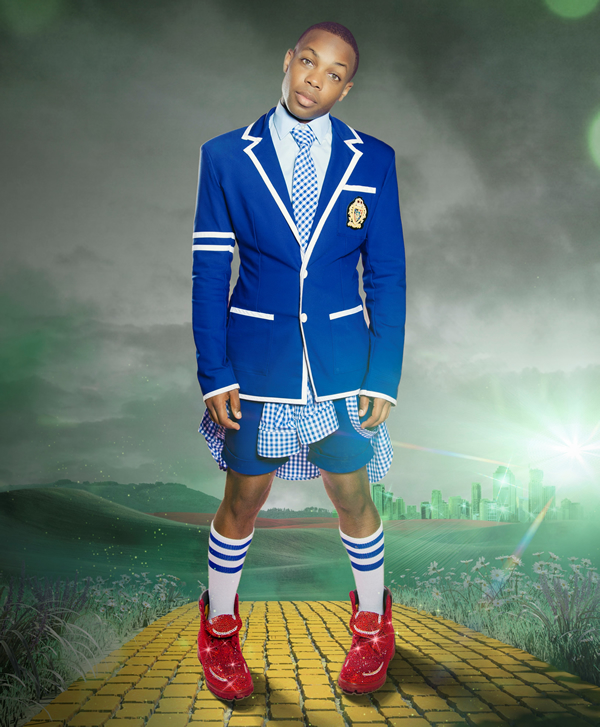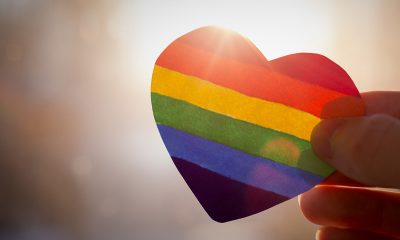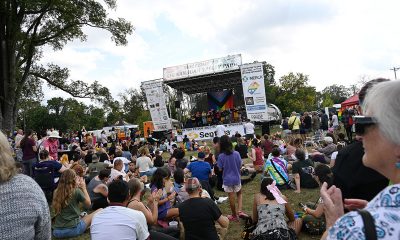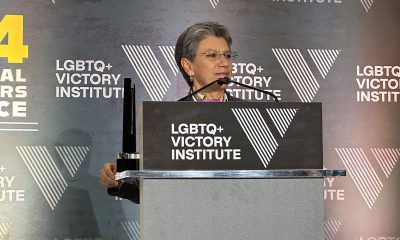a&e features
Todrick Hall on his ‘Oz’ show, RuPaul, ‘Kinky Boots’ and more
Busy performer returns to D.C. for two-night Howard Theatre engagement
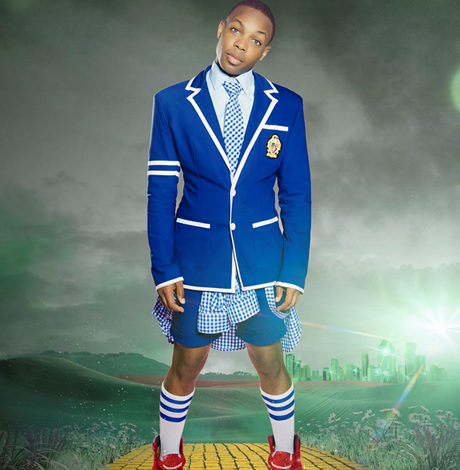
Todrick Hall
‘Straight Outta Oz’
Tuesday, April 18
Wednesday, April 19
8 p.m.
Howard Theatre
620 T St., N.W.
$35-100
Dancer, singer and YouTuber Todrick Hall has become a dance staple with his more than two million subscribers and videos earning millions of views.
The Beyoncé stan became known as an internet sensation for his medley mashups of her songs (as well as Rihanna, Arianna Grande and Taylor Swift). His “End of Time” Target dance flash mob video, where Hall and a group of dancers bust out a choreographed dance routine on unsuspecting shoppers, even grabbed the attention of the Queen B herself. Beyoncé posted a thank you to Hall on her own YouTube page.
His credentials reach beyond YouTube with Hall competing on “American Idol” and being a guest judge on “RuPaul’s Drag Race.” Hall eventually took his talent to Broadway starring as Lola in “Kinky Boots” from November until March of this year.
The 32-year-old choreographer released “Straight Outta Oz,” a semi-autobiographical visual album in a similar vein as his idol Beyoncé’s “Lemonade,” in June with a rerelease of a deluxe edition in March. This time, the celebrities were singing Hall’s original work with appearances from RuPaul, Bob the Drag Queen, Amber Riley, Jordin Sparks, Raven Symoné, Tamar Braxton and more. “Straight Outta Oz” has now been adapted from the computer screen to stage with a live tour.
Hall took a break from rehearsing to speak with the Washington Blade on being out in the public eye, RuPaul’s life advice and just what happened to Lola’s boots.
WASHINGTON BLADE: What about “Wizard of Oz” did you feel such a personal connection to that you wanted to do your own version?
TODRICK HALL: I think subconsciously I’ve always felt that my life was parallel to Dorothy. I just didn’t realize that until last year. I grew up in a small town in Texas. I always knew there was something out there that was greater for me that I wanted to get out there and see. And that’s what Dorothy does. She knew that Oz was there. Even though she realizes in the end that there’s no place like home and that the grass isn’t always greener on the other side, without those experiences she would have never realized those things. I feel like I have realized so many things and put my faith, trust and my career in other people’s hands when really I had the power all along to be able to control my destiny. I realized that and said this is a story that I have to write and tell. If I feel this way and so passionate about it, a lot of other people will feel this way and identify with this as well.
BLADE: The visual album was released in June but in March you released a deluxe edition. Did you think of the additions you made after the initial release?
HALL: No. The initial release was supposed to be much smaller, but I am a perfectionist and I always want to tell the story in full. For me, I said, “Well if you tell the story of Dorothy you have to have the Scarecrow, Tin Man and Lion. If you have those four characters you have to have the Wizard and the Witch.” Eventually the visual album, which was supposed to be eight songs, turned into 16 songs. When we went on tour, my fans really loved the numbers that they were getting to watch that they knew and recognized. But they weren’t able to follow along to the songs that I wrote for the musical that were not a part of the tour. It got to a place where I was like, “I really want them to be able to hear the songs and the lyrics from the songs that we performed at the live concert last year that weren’t on the visual album.” So this year I rereleased it so that the songs that they didn’t know they could learn and be familiar with.
BLADE: The deluxe album has some big names like RuPaul and Raven-Symoné. Did you reach out to them to collaborate?
HALL: I reached out to them and I reached out very last minute. I was so thankful that they all were able to jump on board with sometimes 24-hours notice before they had to shoot the video.
BLADE: You’ve worked with RuPaul on your album and also you were a judge on “RuPaul’s Drag Race” for the last couple seasons. What’s the best piece of advice Ru gave you?
HALL: I don’t know if this is a piece of advice but the entire way that he looks at life. There was a moment of time when my MTV show was on television. It was airing and I was very nervous whether it would be successful. He said, “You need to live in the moment. You need to appreciate that the stars have aligned for you to have this moment and you can’t sit at home every day wondering whether or not it will be successful. It’s successful because it happened. If it doesn’t happen again, you’ll go on and have another opportunity.” My whole life I’ve always put so much pressure on each opportunity I’ve been given. We, as humans, do that often. We think that if this relationship doesn’t work, if this job isn’t the one that gets me to the top, if I don’t ace this test, then my life is over. It’s not the case. It’s a life experience. You will move on and you will be able to experience other things. That’s kind of what he taught me. So now when I’m doing a project, I give it 100 percent of my energy and then I leave that energy in that project and I say, “I hope that this does really well. But if it doesn’t, there’s a reason God gave me these gifts. So I can keep using them.” They’re not over, they’re not done, they’re not running out. I’ll go do something else. His whole insight about everything has really helped me be able to approach everything that I do with a much different lens.
BLADE: Your song “Water Guns” was a tribute to those who were lost to gun violence from the Pulse nightclub victims, to YouTuber Christina Grimmie and Trayvon Martin. All these people are parts of your identity: gay, YouTuber, black. How emotional was it for you to record?
HALL: It was very emotional for me to record. The inspiration for that song was a huge coincidence because I wrote it because I had a friend who got murdered. She was a police officer. Some people perceive that song to be a pro-Black Lives Matter song or an anti-police song. It’s not. My friend was actually an African-American police officer. She was shot and killed. I wrote the song because I’m very anti-guns and anti-violence in general. The night that I wrote the song Christina Grimmie got shot. The next night after we filmed the video the Pulse situation happened. So I went back and shot the scenes of me spray painting the names of these people because it couldn’t have been more relevant at the time that I wrote the song for my friend. That was a crazy coincidence and they both hit me really hard.
Pulse was one of my old stomping grounds. My first job out of high school was dancing at Walt Disney World. I knew a lot of people who worked at that club, I knew a lot of people who were there that night and some of the people who unfortunately didn’t make it out had pictures of me and them on their Instagram. These were people I didn’t know personally but I had met that were fans of mine and came to my concerts. It was just a very weird thing to think this was so close to home and that I could have been there that night. Every time I go to Orlando for my tours I go to Pulse afterward. It was a very scary thing for me and a really eye-opening thing to remind you how fragile life is and we should really live each day to the fullest.
BLADE: You were also on season nine of “American Idol.” You’ve mentioned before that you were concerned about being out while on the show. What made you decide to be out in your career?
HALL: When I was on the show I felt this pressure. They kept saying, “Appeal to middle America,” and what I translated that as was, “Don’t be so openly gay because that could offend people.” I don’t think they were saying it in a mean way. They just wanted me to be successful. After I was eliminated I realized that I got eliminated being someone I wasn’t. I would rather have been eliminated from the show for really showing people who I was. There was nothing I could have thought that was a worse feeling than getting eliminated when I didn’t even recognize the person that I was being on television. I vowed to myself after that, “I will be 100 percent myself and I will be out waving my flag and letting people know who I am.”
I felt it wasn’t important because it wasn’t any of their business. But it’s so important because it gives people that are coming out the confidence to say, “Well if Todrick did it, I can do it. If RuPaul did it, I can do it. If Joey Graceffa, Tyler Oakley, Kingsley and all these people who are such huge influencers online can do it than I can do it as well. There is a place for me in the entertainment industry and I don’t have to hide.” Like Colton Haynes has come out and is being celebrated and I hope and pray it doesn’t do anything negative for his career. He should not only be considered for gay roles, he should be able to play any role that he wants because that’s what actors do. It was very important for me to come and say who I truly am and I would rather maybe not reach the level of success I could have pretended to be straight. I’d rather reach the level of success that I can as the real me and be happy and free to be who I am.
BLADE: You just mentioned quite a few gay YouTubers. As a gay YouTuber yourself, what are your thoughts on the recent controversy of YouTube censoring LGBT content on its restricted mode?
HALL: I don’t know all the details. I don’t like to comment when I’m not educated on something. I was releasing my album during the time that this happened and flying from coast to coast. So I didn’t really get all the information about this. But I am positive that the gay community is so strong that if anything like that were to ever happen we would be able to get it banned and YouTube wouldn’t stand for it. YouTube has an entire department that is dedicated to the LGBTQ community. They do so much research and so much to help our community that I don’t believe this will stand.
BLADE: You have been busy. You just finished your run as Lola on Broadway in, “Kinky Boots.” Did they let you keep the boots?
HALL: Yes they did. My boots might be making a quick appearance in my upcoming tour as well.
BLADE: How do you go about translating the visual album to the stage?
HALL: It’s not a difficult transition for me because I love theater. As I was writing all the songs and shooting the videos I was already thinking of ways to bring it to life on stage. It’s not very complicated. The story kind of tells itself and the staging and a lot of the choreography is the same. We just have transitions that are not on the album still. There are three or four songs that you can only hear on the tour. I think it’s really fun to bring all those things to life on stage in front of everyone.
BLADE: How does it feel to bring “Straight Outta Oz” to D.C.?
HALL: D.C. is just one of my favorite cities to perform in. I love how much D.C. supports its fine arts. I love how much effort and energy they spend to make sure there are theaters there for people to perform in. I love specifically how the Howard Theatre is such a historical venue. It’s such a landmark for people who are African-American performers. I’m so honored to join the roster of legends of people who have performed there before me. There’s something about the energy in that building that just feels really epic. I’m so grateful to be able to get on that stage and share the story of a proud, gay black man. I think it’s very progressive and beautiful and I appreciate D.C. for supporting me the way they do.
a&e features
Queer highlights of the 2026 Critics Choice Awards: Aunt Gladys, that ‘Heated Rivalry’ shoutout and more
Amy Madigan’s win in the supporting actress category puts her in serious contention to win the Oscar for ‘Weapons’

From Chelsea Handler shouting out Heated Rivalry in her opening monologue to Amy Madigan proving that horror performances can (and should) be taken seriously, the Critics Choice Awards provided plenty of iconic moments for queer movie fans to celebrate on the long road to Oscar night.
Handler kicked off the ceremony by recapping the biggest moments in pop culture last year, from Wicked: For Good to Sinners. She also made room to joke about the surprise hit TV sensation on everyone’s minds: “Shoutout to Heated Rivalry. Everyone loves it! Gay men love it, women love it, straight men who say they aren’t gay but work out at Equinox love it!”
The back-to-back wins for Jacob Elordi in Frankenstein and Amy Madigan in Weapons are notable, given the horror bias that awards voters typically have. Aunt Gladys instantly became a pop culture phenomenon within the LGBTQ+ community when Zach Cregger’s hit horror comedy released in August, but the thought that Madigan could be a serious awards contender for such a fun, out-there performance seemed improbable to most months ago. Now, considering the sheer amount of critics’ attention she’s received over the past month, there’s no denying she’s in the running for the Oscar.
“I really wasn’t expecting all of this because I thought people would like the movie, and I thought people would dig Gladys, but you love Gladys! I mean, it’s crazy,” Madigan said during her acceptance speech. “I get [sent] makeup tutorials and paintings. I even got one weird thing about how she’s a sex icon also, which I didn’t go too deep into that one.”
Over on the TV side, Rhea Seehorn won in the incredibly competitive best actress in a drama series category for her acclaimed performance as Carol in Pluribus, beating out the likes of Emmy winner Britt Lower for Severance, Carrie Coon for The White Lotus, and Bella Ramsey for The Last of Us. Pluribus, which was created by Breaking Bad’s showrunner Vince Gilligan, has been celebrated by audiences for its rich exploration of queer trauma and conversion therapy.
Jean Smart was Hack’s only win of the night, as Hannah Einbinder couldn’t repeat her Emmy victory in the supporting actress in a comedy series category against Janelle James, who nabbed a trophy for Abbott Elementary. Hacks lost the best comedy series award to The Studio, as it did at the Emmys in September. And in the limited series category, Erin Doherty repeated her Emmy success in supporting actress, joining in yet another Adolescence awards sweep.
As Oscar fans speculate on what these Critics Choice wins mean for future ceremonies, we have next week’s Golden Globes ceremony to look forward to on Jan. 11.
a&e features
Looking back at the 10 biggest A&E stories of 2025
‘Wicked,’ Lady Gaga’s new era, ‘Sexy’ Bailey and more

Although 2025 was a year marked by countless attacks on trans rights and political setbacks, the year also saw brilliant queer artists continuing to create art. From Cannes and Sundance Award winners now vying for Oscar consideration to pop icons entering new stages of their careers, queer people persevered to tell their stories through different media.
With the state of the world so uncertain, perhaps there’s no more vital time to celebrate our wins, as seen through some of this year’s top pop culture moments. While there’s no collection of 10 stories that fully encompass “the most important” news, here are some events that got the gays going:
10. ‘Mysterious Gaze of the Flamingo’ wins big at Cannes

The Cannes Film Festival has become a crucial start for films hoping to make their way to the Oscars, and first-time director Diego Céspedes won the top Un Certain Regard prize for his intimate western “The Mysterious Gaze of the Flamingo.” The film is set in the ‘80s and is intended as an allegory for the AIDS epidemic. Seeing a film that unpacks vital queer history win one of the most coveted awards at Cannes has been a huge point of pride in the independent filmmaking community.
Since the film bowed at Cannes, it has been selected as Chile’s Oscar entry in the Best International Feature race. Speaking with The Blade during the film’s AFI Fest run in October, Céspedes said: At first, I was kind of scared to have this campaign position in the times that we’re living [in] here. But at the same time, I think the Oscars mean a huge platform — a huge platform for art and politics.”
9. ‘The Last of Us’ returns for an even gayer season 2
While the first season of The Last of Us gave us one of TV’s most heartbreaking queer love stories in the episode “Long, Long Time,” Season 2 doubled down on its commitment to queer storytelling with the blossoming relationship between Ellie (Bella Ramsey) and Dina (Isabela Merced). The show expanded on the pair’s relationship in the original video game, making it perhaps the central dynamic to the entire season. That unfortunately came with more homophobic backlash on the internet, but those who checked out all the episodes saw a tender relationship form amid the show’s post-apocalyptic, often violent backdrop. For their performance, Ramsey was once again nominated for an Emmy, but Merced deserved just as much awards attention.
8. ‘Emilia Pérez’ sparks controversy
Jacques Audiard’s genre-bending trans musical “Emilia Pérez” proved to be an awards season juggernaut this time last year, winning the Golden Globe for Best Musical/Comedy. But when the lead star Karla Sofia Gascón’s racist, sexist, and homophobic old tweets resurfaced, the film’s Oscar campaign became a tough sell, especially after Netflix had tried so hard to sell Emilia Pérez as the “progressive” film to vote for. Mind you, the film had already received significant backlash from LGBTQ+ audiences and the Mexican community for its stereotypical and reductive portrayals, but the Gascón controversy made what was originally just social media backlash impossible to ignore. The only person who seemed to come out of the whole debacle unscathed was Zoe Saldaña, who won the Oscar for Best Supporting Actress over Ariana Grande.
7. ‘Sorry, Baby’ establishes Eva Victor as major talent
Back in January at the Sundance Film Festival, Eva Victor (known by many for her brand of sketch comedy) premiered their directorial debut “Sorry, Baby” to rave reviews, even winning the Waldo Salt Screening Award. Victor shadowed Jane Schoenbrun on the set of “I Saw the TV Glow,” and seeing Victor come into their own and establish such a strong voice immediately made them one of independent cinema’s most exciting new voices. A memorable scene in the film sees the main character, Agnes (played by Victor), struggling to check a box for male or female, just one example of how naturally queerness is woven into the fabric of the story.
Most recently, Victor was nominated for a Golden Globe for her performance in the film, and she’s represented in a category alongside Jennifer Lawrence (“Die My Love”), Jessie Buckley (“Hamnet”), Julia Roberts (“After the Hunt”), Renate Reinsve (“Sentimental Value”) and Tessa Thompson (“Hedda”). The film also received four Independent Spirit Award nominations overall.
6. Paul Reubens comes out in posthumous doc

While Paul Reubens never publicly came out as gay before passing away in 2023, the two-part documentary “Pee-wee as Himself” premiered back in May on HBO Max, giving the legendary comedian a chance to posthumously open up to the world. Directed by Matt Wolf, the documentary explores how Reubens found his alter ego Pee-Wee Herman and why he kept his private life private.
The documentary won an Emmy in the Outstanding Documentary or Nonfiction Special category and remains one of the most critically acclaimed titles of the year with a 100% Rotten Tomatoes score. Also worth noting, the National Geographic documentary Sally told the posthumous coming out story of Sally Ride through the help of her long-time partner, Tam O’Shaughnessy.
5. Lady Gaga releases ‘Mayhem’
Lady Gaga entered a new phase of her musical career with the release of Mayhem, her seventh album to date. From the frenzy-inducing pop hit Abracadabra to the memorable Bruno Mars duet featured on “Die With a Smile,” seeing Gaga return to her roots and make an album for the most die-hard of fans was especially rewarding after the underwhelming film releases of “House of Gucci” and “Joker: Folie à Deux.” Gaga has been touring with The Mayhem Ball since July, her first arena tour since 2018. She even extended her tour into 2026 with more North American dates, so the party isn’t stopping anytime soon. And Gaga is even set to make an appearance next May in “The Devil Wears Prada 2.”
4. Cynthia Erivo, Ariana Grande perform at the Oscars

While “Wicked: For Good” didn’t quite reach the heights of the first film, we will forever have Cynthia Erivo and Ariana Grande’s breathtaking live performance that opened the 97th Academy Awards. The pair sang a rendition of “Over the Rainbow,” “Home,” and “Defying Gravity,” paying proper homage to the original 1939 “Wizard of Oz.” Even non-Wicked fans can’t deny how magical and brilliantly staged this performance was. With both Erivo and Grande up for acting Oscars last year, they’re hoping to repeat success and make history with consecutive nominations. Either way, let’s hope there’s another live performance in the making, especially with two new original songs (The Girl in the Bubble and No Place Like Home) in the mix.
3. Indya Moore speaks out against Ryan Murphy
Indya Moore has consistently used social media as a platform for activism, and in September, posted a 30-minute Instagram live speaking out against “Pose” co-creator Ryan Murphy. Moore claimed that Murphy wasn’t being a true activist for trans people. “Ryan Murphy, we need you to do more. You need to address the racism, the violence, and the targeting of people on your productions, Ryan Murphy. You do need to make sure trans people are paid equally. Yes, Janet did the right thing,” Moore said. Murphy was also back in the headlines this year for the critically panned “All’s Fair” and the controversial “Monster: The Ed Gein Story” starring Laurie Metcalf and Charlie Hunnam.
2. Cole Escola wins Tony for Best Leading Actor
Few pop culture moments this year brought us together more than Cole Escola winning a Tony award for “Oh, Mary!” the Broadway show they created, wrote and starred in (we love a triple threat!) Escola made history by becoming the first nonbinary person to win a Tony in the leading actor category, and seeing them excitedly rush to the stage wearing a Bernadette Peters-inspired gown instantly became a viral social media moment.
The cherry on top of Escola’s major moment is the recent news that they are writing a Miss Piggy movie with Jennifer Lawrence and Emma Stone producing — news that also broke the internet for the better. We cannot wait!
1. Jonathan Bailey makes gay history as ‘Sexiest Man Alive’

The same year as his on-screen roles in blockbusters “Jurassic World Rebirth” and “Wicked: For Good,” Jonathan Bailey made history as the first openly gay man to be named People magazine’s “Sexiest Man Alive.” The fact that it took 40 years for an openly gay man to earn the title is a signifier of how far we still have to go with queer representation, and seeing Bailey celebrated is just one small step in the right direction.
“There’s so many people that want to do brilliant stuff who feel like they can’t,” he told PEOPLE, “and I know the LGBT sector is under immense threat at the moment. So it’s been amazing to meet people who have the expertise and see potential that I could have only dreamed of.” In 2024, Bailey founded the charity titled The Shameless Fund, which raises money for LGBTQ+ organizations.
a&e features
Your guide to D.C.’s queer New Year’s Eve parties
Ring in 2026 with drag, leather, Champagne, and more

With Christmas in the rear view mirror, we can turn our attention to ringing in a much-anticipated New Year with a slew of local LGBTQ parties. Here’s what’s on tap.
Pitchers
This spacious Adams Morgan bar is hosting the “Pitchers’ Perfect New Year’s Eve.” There will be a midnight Champagne toast, the ball drop on the big screens, and no cover, all night long. The bar doesn’t close until 4 a.m., and the kitchen will be open late (though not until close). All five floors will be open for the party, and party favors are promised.
Trade
D.C.’s hottest bar/club combo is leaning into the Shark motif with its NYE party, “Feeding Frenzy.” The party is a “glitterati-infused Naughty-cal New Year’s Even in the Shark Tank, where the boats are churning and the sharks are circling.” Trade also boasts no cover charge, with doors opening at 5 p.m. and the aforementioned Shark Tank opening at 9 p.m.. Four DJs will be spread across the two spaces; midnight hostess is played by Vagenesis and the two sea sirens sensuously calling are Anathema and Justin Williams.
Number Nine
While Trade will have two DJs as part of one party, Number Nine will host two separate parties, one on each floor. The first floor is classic Number Nine, a more casual-style event with the countdown on TVs and a Champagne midnight toast. There will be no cover and doors open at 5 p.m. Upstairs will be hosted by Capital Sapphics for its second annual NYE gathering. Tickets (about $50) include a midnight Champagne toast, curated drink menu, sapphic DJ set by Rijak, and tarot readings by Yooji.
Crush
Crush will kick off NYE with a free drag bingo at 8 p.m. for the early birds. Post-bingo, there will be a cover for the rest of the evening, featuring two DJs. The cover ($20 limited pre-sale that includes line skip until 11 p.m.; $25 at the door after 9 p.m.) includes one free N/A or Crush, a Champagne toast, and party favors (“the legal kind”). More details on Eventbrite.
Bunker
This subterranean lair is hosting a NYE party entitled “Frosted & Fur: Aspen After Dark New Year’s Eve Celebration.” Arriety from Rupaul Season 15 is set to host, with International DJ Alex Lo. Doors open at 9 p.m. and close at 3 p.m.; there is a midnight Champagne toast. Cover is $25, plus an optional $99 all-you-can-drink package.
District Eagle
This leather-focused bar is hosting “Bulge” for its NYE party. Each District Eagle floor will have its own music and vibe. Doors run from 7 p.m.-3 a.m. and cover is $15. There will be a Champagne toast at midnight, as well as drink specials during the event.
Kiki, Shakiki
Kiki and its new sister bar program Shakiki (in the old Shakers space) will have the same type of party on New Year’s Eve. Both bars open their doors at 5 p.m. and stay open until closing time. Both will offer a Champagne toast at midnight. At Kiki, DJ Vodkatrina will play; at Shakiki, it’ll be DJ Alex Love. Kiki keeps the party going on New Year’s Day, opening at 2 p.m., to celebrate Kiki’s fourth anniversary. There will be a drag show at 6 p.m. and an early 2000s dance party 4-8 p.m.
Spark
This bar and its new menu of alcoholic and twin N/A drinks will host a NYE party with music by DJ Emerald Fox. Given this menu, there will be a complimentary toast at midnight, guests can choose either sparkling wine with or without alcohol. No cover, but Spark is also offering optional wristbands at the door for $35 open bar 11 p.m.-1 a.m. (mid-shelf liquor & all NA drinks).
-

 National5 days ago
National5 days agoWhat to watch for in 2026: midterms, Supreme Court, and more
-

 Opinions5 days ago
Opinions5 days agoA reminder that Jan. 6 was ‘textbook terrorism’
-

 Colombia5 days ago
Colombia5 days agoClaudia López criticizes Trump over threats against Colombian president
-

 District of Columbia4 days ago
District of Columbia4 days agoImperial Court of Washington drag group has ‘dissolved’

